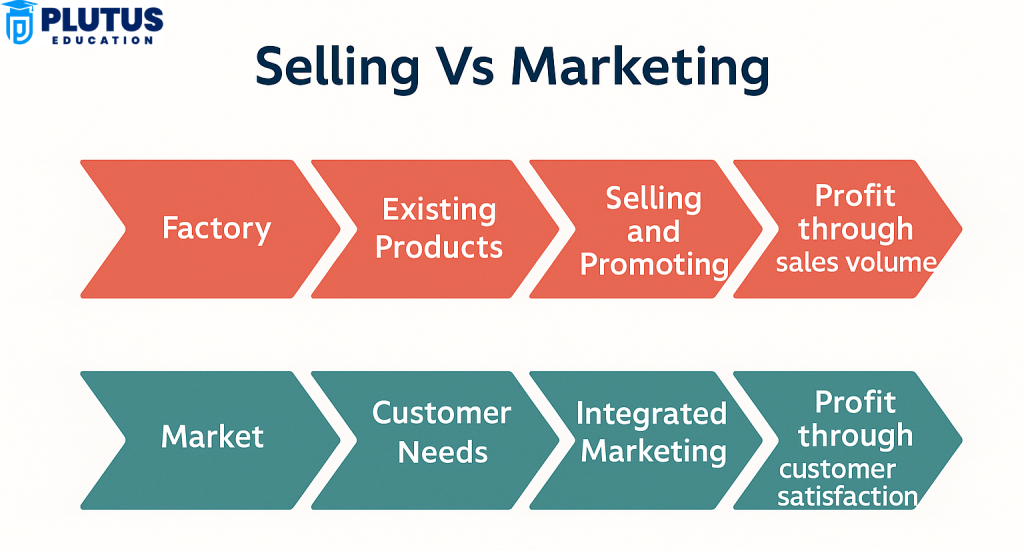Selling and marketing have generally been understood as synonyms by many businesspeople. Still, each encompasses its distinct teachings, interrelated to the other. Selling is concerned with closing a deal, whereas marketing is a much wider field that envisions increasing awareness, arousing interest, and developing value in the long term. When companies are clear on the difference, they can sharpen their approach into something yielding sustainable growth. In a perpetual war for customers’ attention and loyalty in an ever-expanding digital marketplace, distinguishing between selling and marketing is critical. Marketing lays the stage by determining customer needs, fostering demand, and selling converts that interest into action. Both functions are necessary along the customer journey, but serve different purposes.
What is Selling?
Selling is a process that seems to be the last step in such a business, in which the company persuades a potential customer to make a purchase. Direct, personal, and frequently one-on-one, the selling process actively engages the seller in convincing the buyer. Normally, your transactional, quick results are the aim of this process. The marketing effort follows product development; selling is the last step, and interactive persuasion is used to get a product into the market through discounts and negotiating. In considering the fast-paced retailing or B2B sales environment, selling ensures that every sales target or revenue goal is attained.
What is Marketing?
For long-term strategies and customer-centred targeted discipline concerned with identifying, understanding, and satisfying customer needs, marketing creates the environment in which selling is favoured. Unlike selling, which stands at the end of the purchasing funnel, marketing begins before a product is created. It encompasses product design and pricing, promotion, branding, and management of customer relationships.
Differences Between Selling and Marketing
Marketing generates awareness and establishes a demand for a product; selling entails convincing customers to sign a contract. By knowing the difference between marketing and selling, a business can utilize both for greater efficiency and systems building. The detailed differences between the two are discussed below:-

Focus and Time Frame
These two concepts are worlds apart concerning configuration and system behavior; At the same time, selling concentrates on short-term, result-oriented target programs, while marketing operates long-term, focusing on sustainable brand equity and customer loyalty. Therefore, while selling is about immediate revenue, marketing delivers leads and creates the raw materials for selling in the first place.
Customer Approach
It is primarily transactional and persuasive with an emphasis on closure. In contrast, it is more empathetic and informative, seeking an understanding of the customer. Marketing nurtures leads through different stages, easing and facilitating the eventual sale.
Scope of Activities
Selling includes price negotiation, discounting, and direct participation. Marketing activities embrace market analysis, product development, branding, and promotions. In light of this, marketing encompasses more, implanting it better into the overall company strategy.
Communication Mode
“Personal” describes selling because it’s through one-on-one exchanges. Marketing resorts to “mass” media, content, and advertising communication. Such dissimilarities in communication mode change scales-marketing touches many, and selling pulls only a few.
Goal and Objectives
Selling translates leads into orders. Marketing creates awareness and interest and develops long-term relationships. While sales show an immediate impact, marketing prepares the ground for future success.
Dependency
Selling is marketing dependent, at least to some degree, on creating awareness and interest. Without marketing, there won’t be a demand to fulfill. This dependency accentuates the interconnectivity between the two: selling is a part of marketing, yet marketing is much bigger.
| Aspect | Selling | Marketing |
| Definition | Selling is persuading the customer to buy a product or service. | Marketing is the strategic process of identifying and fulfilling customer needs to drive business. |
| Core Objective | To complete the sale and convert leads into paying customers. | To create awareness, generate interest, and build long-term customer relationships. |
| Approach | Product-focused and transactional. | Customer-focused and value-driven. |
| Process Timing | Comes after the product is ready. | Begins before product creation with research and planning. |
| Time Horizon | Short-term focuses on immediate results and sales targets. | Long-term aims for sustained customer engagement and loyalty. |
| Customer Interaction | Direct, often face-to-face or personal interaction (e.g., sales calls, demos). | Indirectly through advertising, PR, branding, and content marketing. |
| Goal Orientation | Closing deals and boosting immediate revenue. | Building brand value, customer satisfaction, and market share. |
| Strategy Type | Push strategy – pushing the product onto customers. | Pull strategy – attracting customers through value propositions. |
| Tools Used | Personal selling, telemarketing, discounts, and door-to-door sales. | Advertising, market research, branding, digital marketing, promotions. |
| Focus on Customer Needs | Low – focuses more on the product being sold. | High begins by understanding and solving customer problems. |
| Market Research Role | Minimal or no role – rarely involves customer insights. | Integral – involves deep research to guide decisions and strategies. |
| Performance Metrics | Number of deals closed, sales volume, conversion rate. | Customer engagement, brand reach, lead generation, and customer retention. |
| Relationship Building | Limited to transaction duration; less focus on long-term ties. | Strong focus on nurturing relationships and repeat business. |
| Scope of Work | Narrow – limited to the act of selling. | Broad – includes product development, pricing, distribution, and promotion. |
| Dependency | Dependent on marketing to generate interest and leads. | Operates independently to create awareness and interest before sales begin. |
Features of Marketing
Marketing is a comprehensive business function that focuses on identifying customer needs and satisfying them profitably. It goes beyond just selling a product—it involves research, planning, communication, distribution, and customer relationship management to create value.
Customer-Centric by Design
Marketing functions begin with the customer’s much-analysed needs, wants, and pain points. Campaigns, messages, and product features are created primarily with the end-user in mind. Such an approach gives one long-term sustainability, as the marketing function ensures the product/service is geared towards the existing market demand.
Research-Driven Strategy
Before the launch of a product, marketers may conduct surveys, focus groups, or competitive analysis to derive the best positioning for it. Data-backed strategies allow businesses to make informed decisions, thus minimising risk and raising ROI from campaign to campaign.
Brand Building and Awareness
Primarily, marketing seeks to create strong brand identities, from logo design to the right messaging and brand voice to overall customer perception. A strong brand sells, builds trust, and grants repeat customers and mouth-to-mouth marketing.
Long-Term Relationship Focus
Marketing isn’t just about the first sale. It’s about nurturing relationships through email campaigns, loyalty programs, and social media engagement. The goal is to turn one-time buyers into lifelong brand advocates, a concept that selling alone cannot achieve.
Omnichannel Communication
Marketing uses various touchpoints—social media, content marketing, advertising, PR, and SEO—to engage customers across their preferred platforms. This multi-platform approach ensures consistency and helps brands stay top-of-mind throughout the buyer journey.
Examples of Marketing
Advertising, influencer partnerships, email newsletters, PR campaigns, search engine optimization, and even product packaging are all part of marketing. These examples show how broad marketing creates demand and lays the groundwork for successful selling.
Features of Selling
Selling is a narrow, action-oriented component of marketing, aimed at persuading the customer to buy a product or service. It focuses more on pushing the product to generate immediate revenue rather than building long-term customer relationships.
Transactional in Nature
In selling, the primary purpose is to accomplish a sale by modifying the will of the customer. It centers upon hawking the product, unconcerned about the preferences or loyalty of the customer in the long run. Such a short-term objective may make sellers, at times, focus on the volume rather than value by using discounts, urgency, and persuasion to hastily close a sale.
Sales Target Oriented
Sales departments usually set these targets monthly or quarterly. Their performance is measured by how much they sell, not by how many people they engage, educate, or are inspired to action. The goal-oriented structure causes a more aggressive selling style, where the present performance is given precedence over much-needed brand sustenance.
Personal Interaction and Persuasion
Selling involves direct communication in person, over the phone, or through email. The salesperson addresses objections, answers questions, and guides the customer toward a purchase decision. This personalized approach builds trust in the short term and is especially useful in industries that require complex decision-making or high-value purchases.
Less Focus on Research
Unlike marketing, selling typically doesn’t begin with customer insights or market analysis. It’s more about reacting to existing needs rather than discovering new ones. As a result, selling can sometimes feel disconnected from consumer behavior trends or long-term strategy.
Examples of Selling
Selling occurs in many forms—retail employees, B2B sales calls, door-to-door selling, or direct mail campaigns all fall into this category. Each focuses on immediate response and transaction, reinforcing that selling is about closure, not the creation of demand.
What Does a Company Need for Efficient Selling and Marketing?
Selling and marketing success needs an amalgamation of tools, data, and tactics. A successful company should be able to understand the customer thoroughly and build campaigns or sales pitches that resonate with him/her. The two keys that turn the wheels of success for an organization are consistency and customer orientation. Companies that bring balance to their selling and marketing functions witness a seamless customer journey, enhanced brand loyalty, and ultimately better conversions. Hence, these two functions must collaborate to achieve overall success.
Clear-Bound Branding and Positioning
Branding should pass on a consistent message regarding value to the target audience. This enhances the effectiveness of both marketing communication and sales pitches. All of this works towards building branding that creates trust, and trust is the most precious asset any brand can have, especially in the context of competition.
Market and Customer Research
Understanding the target audience helps marketing craft relevant messages and helps sales teams anticipate objections and concerns. Customer personas, buying behavior, and industry trends provide a blueprint for both teams to work in sync.
Product Knowledge
Both marketers and sellers need detailed knowledge of the product’s features, benefits, and unique selling propositions. This knowledge allows for tailored communication—marketers use it to educate, and sellers use it to persuade.
Effective Communication Channels
Businesses should use email, social media, content marketing, and CRM tools to engage customers at every funnel stage. Consistency across all communication channels enhances trust and keeps the brand top-of-mind.
Customer Relationship Management
Marketing uses automation and content to keep prospects engaged. Sales teams use CRM tools to personalize follow-ups and maintain relationships post-sale. Long-term customer engagement leads to repeat purchases, referrals, and sustainable growth.
Selling Closes the Deal, Marketing Builds the Path
While both selling and marketing aim to generate revenue, they do so in fundamentally different ways. Selling is focused on the end of the buyer journey—closing deals and meeting quotas. Marketing is concerned with the entire journey, from awareness to loyalty. Businesses that integrate both strengths can achieve short-term wins and long-term growth. Selling without marketing is like harvesting without planting. Marketing without selling is like planting without harvesting. A smart business understands how to balance both for sustained success.
Selling vs Marketing FAQs
What is selling in business?
Selling is convincing a customer to purchase a product or service through direct interaction, usually focusing on closing the deal and achieving short-term goals.
What is marketing in simple words?
Marketing is the strategic process of understanding customer needs and creating campaigns to build awareness, generate interest, and maintain long-term customer relationships.
What is the main difference between marketing and selling?
The main difference lies in scope: selling is transaction-focused and short-term, while marketing is customer-focused and long-term, covering everything from product development to brand loyalty.
How does marketing support selling?
Marketing creates awareness and demand, bringing potential customers into the sales funnel, where selling takes over to convert interest into purchases.
Is selling a part of marketing?
Yes, selling is considered a part of marketing. It comes at the final stage of the marketing process, where the potential customer is converted into an actual buyer.


